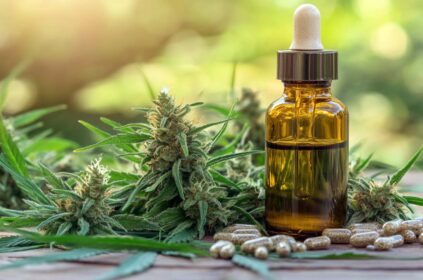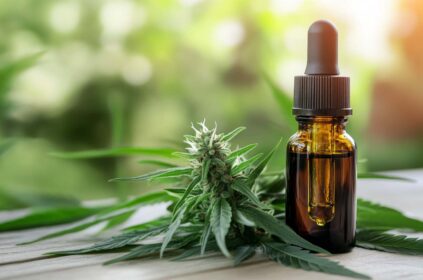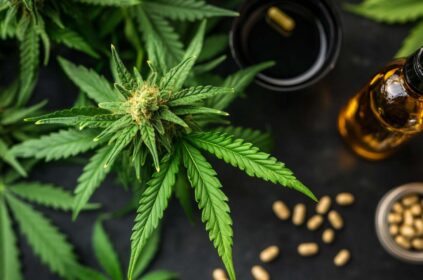In the vast and intricate landscape of human biology, the endocannabinoid system stands out as a crucial regulatory network that helps maintain homeostasis — a stable internal environment vital for proper health. This system is largely comprised of cannabinoid receptors, especially the two main types: CB1 and CB2. Understanding these receptors and the endocannabinoid system is key to appreciating the role of hemp and its derivatives, particularly the exciting realm of CBD (cannabidiol). This guide seeks to explore these topics, elucidating their significance in health and wellness.
Understanding Cannabinoid Receptors
To begin, let’s delve deeper into cannabinoid receptors, starting with the CB1 receptors.
CB1 Receptors
CB1 receptors are among the most widely expressed G protein-coupled receptors in the human body. Predominantly located in the central nervous system, they influence various physiological processes ranging from movement and sensory perception to emotional regulation.
- Location and Function: CB1 receptors are primarily found in the brain and spinal cord. They play a vital role in inhibiting the release of neurotransmitters such as GABA, impacting the way signals are transmitted throughout the nervous system.
- Physiological Roles: Beyond neurological functions, CB1 receptors also impact appetite, energy metabolism, and even pain perception. Their presence in other tissues, like the heart and intestines, underscores their broad physiological importance.
CB2 Receptors
Turning our attention to CB2 receptors, these are primarily associated with the immune system. They serve distinct functions compared to CB1 receptors, emphasizing their roles in immune response and inflammation regulation.
- Location and Function: While CB2 receptors are not typically found in the central nervous system, they are abundant in immune cells including T-cells and B-cells. Their activation can modulate cytokine release and influence immune cell activity.
- Physiological Roles: CB2 receptors significantly impact procedures related to inflammation and immune functions. They help manage pain and inflammation while promoting the body’s delicate balance in response to stressors.
The Endocannabinoid System
At the heart of this networking system lies the endocannabinoid system itself. This complex framework includes cannabinoid receptors, the endocannabinoids they react with, and the enzymes that synthesize and break down these compounds.
Endocannabinoids
Endocannabinoids are naturally occurring molecules in the body that engage with cannabinoid receptors to regulate various functions.
- Synthesis and Function: The primary endocannabinoids, anandamide and 2-arachidonoylglycerol (2-AG), are synthesized in response to physiology changes and stressors. Their role is crucial in modulating receptor activity to keep the body in balance.
- Examples: Anandamide, often linked to feelings of bliss, binds to CB1 receptors, while 2-AG works with both CB1 and CB2 receptors. Each engages in processes that govern mood, pain, appetite, and immune response.
Homeostasis and the Endocannabinoid System
Homeostasis, or the body’s ability to maintain stable internal conditions despite external changes, is heavily regulated by the endocannabinoid system.
- Regulation of Physiological Processes: This system influences gastrointestinal function, cardiovascular health, pain sensitivity, and even hormonal balance, proving its integral role in overall wellness.
- Therapeutic Potential: By modulating the endocannabinoid system, there’s potential for treating varied conditions such as chronic pain, anxiety, and metabolic disorders. This therapeutic avenue is gaining traction in both clinical and holistic health discussions.
Benefits and Uses of Hemp-Derived Products
With increasing interest in hemp-derived products, understanding their benefits — particularly those containing CBD — is more important than ever.
CBD Oil Benefits
CBD oil, derived from hemp, presents a remarkable assortment of health benefits without the psychoactive properties associated with THC.
- Pain Relief: Research shows that CBD can effectively reduce chronic pain, making it a valuable option for those struggling with persistent discomfort.
- Anxiety and Sleep: Many users report improvements in anxiety levels and sleep quality, indicating that CBD may help regulate emotional and cognitive functions through its interaction with the endocannabinoid system.
- Inflammation: The anti-inflammatory properties of CBD are attributed to its ability to engage with CB2 receptors, offering potential relief for conditions characterized by inflammation.
Other Hemp-Derived Products
Beyond CBD, other cannabinoids like CBG (cannabigerol) and CBN (cannabinol) are being explored for their unique benefits.
- CBG: Often referred to as the “mother of all cannabinoids,” CBG is known for its potential to enhance focus and cognitive clarity.
- CBN: This cannabinoid is gaining attention for its possible sleep-enhancing properties, making waves in the wellness community.
- Topicals: Hemp-derived topical formulations can provide direct relief for localized pain and skin issues, utilizing their interaction with cannabinoid receptors in the skin.
Market Impact and Trends in the U.S.
The market for hemp-derived products has experienced significant growth, particularly after the 2018 Farm Bill legalized the cultivation and commercialization of industrial hemp.
- Regulatory Environment: As the industry matures, regulatory bodies like the FDA are working to ensure product safety, efficacy, and proper labeling practices, aiming to protect consumers while encouraging innovation.
- Consumer Demand: There’s a surging interest in natural wellness products, with consumers increasingly seeking out high-quality, research-backed solutions. The ongoing evolution of this market reflects both public interest and scientific exploration of hemp’s myriad benefits.
Conclusion
The endocannabinoid system, with its intricate network of CB1 and CB2 receptors, plays a pivotal role in maintaining bodily homeostasis. As we uncover the complexities of this system and its associated cannabinoids, particularly CBD, we find a promising landscape for natural wellness and holistic health solutions. For advocates of health, understanding this system and the therapeutic potential of hemp-derived products opens up exciting pathways toward better health.
Actionable Tips
- Consult a Healthcare Professional: Consider speaking with a healthcare practitioner experienced in cannabinoid therapy before starting any hemp-derived product.
- Choose High-Quality Products: Opt for products from reputable brands that prioritize quality through third-party lab testing, ensuring their efficacy and safety.
- Stay Informed: Keeping up to date with research findings and industry regulations can empower you to make well-informed decisions regarding hemp and its myriad benefits.
By gaining insights into cannabinoid receptors and the endocannabinoid system, individuals can better navigate their health journeys, leveraging natural processes that promote balance and wellbeing. This burgeoning field of study provides a glimmer of hope for many, making the prospect of using hemp-derived products not just a trend, but a pathway toward natural health solutions.





















